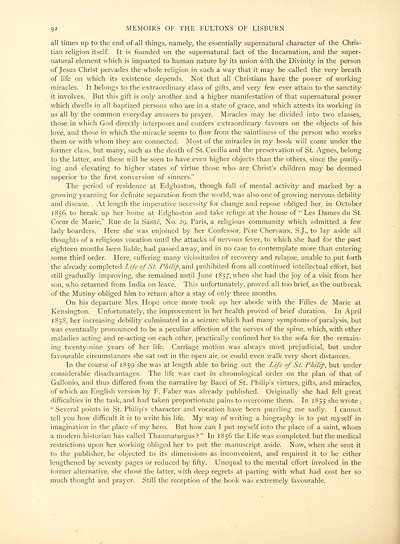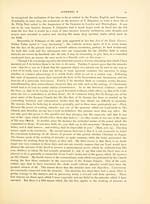Memoirs of the Fultons of Lisburn
(102) Page 92
Download files
Complete book:
Individual page:
Thumbnail gallery: Grid view | List view

92 MEMOIRS OF THE FULTONS OF LISBURN
all times up to the end of all things, namely, the essentially supernatural character of the Chris-
tian religion itself. It is founded on the supernatural fact of the Incarnation, and the super-
natural element which is imparted to human nature by its union with the Divinity in the person
of Jesus Christ pervades the whole religion in such a way that it may be called the very breath
of life on which its existence depends. Not that all Christians have the power of working
miracles. It belongs to the extraordinary class of gifts, and very few ever attain to the sanctity
it involves. But this gift is only another and a higher manifestation of that supernatural power
which dwells in all baptized persons who are in a state of grace, and which attests its working in
us all by the common everyday answers to prayer. Miracles may be divided into two classes,
those in which God directly interposes and confers extraordinary favours on the objects of his
love, and those in which the miracle seems to flow from the saintliness of the person who works
them or with whom they are connected. Most of the miracles in my book will come under the
former class, but many, such as the death of St. Cecilia and the preservation of St. Agnes, belong
to the latter, and these will be seen to have even higher objects than the others, since the purify-
ing and elevating to higher states of virtue those who are Christ's children may be deemed
superior to the first conversion of sinners."
The period of residence at Edgbaston, though full of mental activity and marked by a
growing yearning for definite separation from the world, was also one of growing nervous debility
and disease. At length the imperative necessity for change and repose obliged her, in October
1856, to break up her home at Edgbaston and take refuge at the house of " Les Dames du St.
Cceur de Marie," Rue de la Sante, No. 29, Paris, a religious community which admitted a few
lady boarders. Here she was enjoined by her Confessor, Pere Chervaux, S.J., to lay aside all
thoughts of a religious vocation until the attacks of nervous fever, to which she had for the past
eighteen months been liable, had passed away, and in no case to contemplate more than entering
some third order. Here, suffering many vicissitudes of recovery and relapse, unable to put forth
the already completed Life of St. Philip, ax\& prohibited from all continued intellectual effort, but
still gradually improving, she remained until June 1857, when she had the joy of a visit from her
son, who returned from India on leave. This unfortunately, proved all too brief, as the outbreak
of the Mutiny obliged him to return after a stay of only three months.
On his departure Mrs. Hope once more took up her abode with the Filles de Marie at
Kensington. Unfortunately, the improvement in her health proved of brief duration. In April
1858, her increasing debility culminated in a seizure which had many symptoms of paralysis, but
was eventually pronounced to be a peculiar affection of the nerves of the spine, which, with other
maladies acting and re-acting on each other, practically confined her to the sofa for the remain-
ing twenty-nine years of her life. Carriage motion was always most prejudicial, but under
favourable circumstances she sat out in the open air, or could even walk very short distances.
In the course of 1859 she was at length able to bring out the Life of St. Philip, but under
considerable disadvantages. The life was cast in chronological order on the plan of that of
Gallonio, and thus differed from the narrative by Bacci of St. Philip's virtues, gifts, and miracles,
of which an English version by F. Faber was already published. Originally she had felt great
difficulties in the task, and had taken proportionate pains to overcome them. In 1855 she wrote :
" Several points in St. Philip's character and vocation have been puzzling me sadly. I cannot
tell you how difficult it is to write his life. My way of writing a biography is to put myself in
imagination in the place of my hero. But how can I put myself into the place of a saint, whom
a modern historian has called Thaumaturgus? " In 1856 the Life was completed, but the medical
restrictions upon her working obliged her to put the manuscript aside. Now, when she sent it
to the publisher, he objected to its dimensions as inconvenient, and required it to be either
lengthened by seventy pages or reduced by fifty. Unequal to the mental effort involved in the
former alternative, she chose the latter, with deep regrets at parting with what had cost her so
much thought and prayer. Still the reception of the book was extremely favourable.
all times up to the end of all things, namely, the essentially supernatural character of the Chris-
tian religion itself. It is founded on the supernatural fact of the Incarnation, and the super-
natural element which is imparted to human nature by its union with the Divinity in the person
of Jesus Christ pervades the whole religion in such a way that it may be called the very breath
of life on which its existence depends. Not that all Christians have the power of working
miracles. It belongs to the extraordinary class of gifts, and very few ever attain to the sanctity
it involves. But this gift is only another and a higher manifestation of that supernatural power
which dwells in all baptized persons who are in a state of grace, and which attests its working in
us all by the common everyday answers to prayer. Miracles may be divided into two classes,
those in which God directly interposes and confers extraordinary favours on the objects of his
love, and those in which the miracle seems to flow from the saintliness of the person who works
them or with whom they are connected. Most of the miracles in my book will come under the
former class, but many, such as the death of St. Cecilia and the preservation of St. Agnes, belong
to the latter, and these will be seen to have even higher objects than the others, since the purify-
ing and elevating to higher states of virtue those who are Christ's children may be deemed
superior to the first conversion of sinners."
The period of residence at Edgbaston, though full of mental activity and marked by a
growing yearning for definite separation from the world, was also one of growing nervous debility
and disease. At length the imperative necessity for change and repose obliged her, in October
1856, to break up her home at Edgbaston and take refuge at the house of " Les Dames du St.
Cceur de Marie," Rue de la Sante, No. 29, Paris, a religious community which admitted a few
lady boarders. Here she was enjoined by her Confessor, Pere Chervaux, S.J., to lay aside all
thoughts of a religious vocation until the attacks of nervous fever, to which she had for the past
eighteen months been liable, had passed away, and in no case to contemplate more than entering
some third order. Here, suffering many vicissitudes of recovery and relapse, unable to put forth
the already completed Life of St. Philip, ax\& prohibited from all continued intellectual effort, but
still gradually improving, she remained until June 1857, when she had the joy of a visit from her
son, who returned from India on leave. This unfortunately, proved all too brief, as the outbreak
of the Mutiny obliged him to return after a stay of only three months.
On his departure Mrs. Hope once more took up her abode with the Filles de Marie at
Kensington. Unfortunately, the improvement in her health proved of brief duration. In April
1858, her increasing debility culminated in a seizure which had many symptoms of paralysis, but
was eventually pronounced to be a peculiar affection of the nerves of the spine, which, with other
maladies acting and re-acting on each other, practically confined her to the sofa for the remain-
ing twenty-nine years of her life. Carriage motion was always most prejudicial, but under
favourable circumstances she sat out in the open air, or could even walk very short distances.
In the course of 1859 she was at length able to bring out the Life of St. Philip, but under
considerable disadvantages. The life was cast in chronological order on the plan of that of
Gallonio, and thus differed from the narrative by Bacci of St. Philip's virtues, gifts, and miracles,
of which an English version by F. Faber was already published. Originally she had felt great
difficulties in the task, and had taken proportionate pains to overcome them. In 1855 she wrote :
" Several points in St. Philip's character and vocation have been puzzling me sadly. I cannot
tell you how difficult it is to write his life. My way of writing a biography is to put myself in
imagination in the place of my hero. But how can I put myself into the place of a saint, whom
a modern historian has called Thaumaturgus? " In 1856 the Life was completed, but the medical
restrictions upon her working obliged her to put the manuscript aside. Now, when she sent it
to the publisher, he objected to its dimensions as inconvenient, and required it to be either
lengthened by seventy pages or reduced by fifty. Unequal to the mental effort involved in the
former alternative, she chose the latter, with deep regrets at parting with what had cost her so
much thought and prayer. Still the reception of the book was extremely favourable.
Set display mode to:
![]() Universal Viewer |
Universal Viewer | ![]() Mirador |
Large image | Transcription
Mirador |
Large image | Transcription
Images and transcriptions on this page, including medium image downloads, may be used under the Creative Commons Attribution 4.0 International Licence unless otherwise stated. ![]()
| Histories of Scottish families > Memoirs of the Fultons of Lisburn > (102) Page 92 |
|---|
| Permanent URL | https://digital.nls.uk/95604361 |
|---|
| Description | A selection of almost 400 printed items relating to the history of Scottish families, mostly dating from the 19th and early 20th centuries. Includes memoirs, genealogies and clan histories, with a few produced by emigrant families. The earliest family history goes back to AD 916. |
|---|

